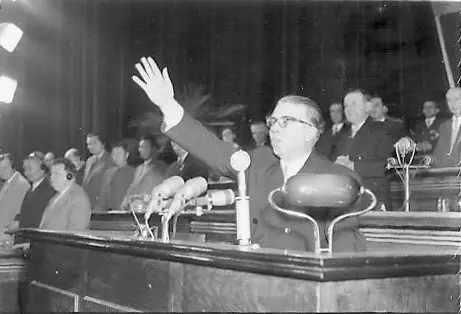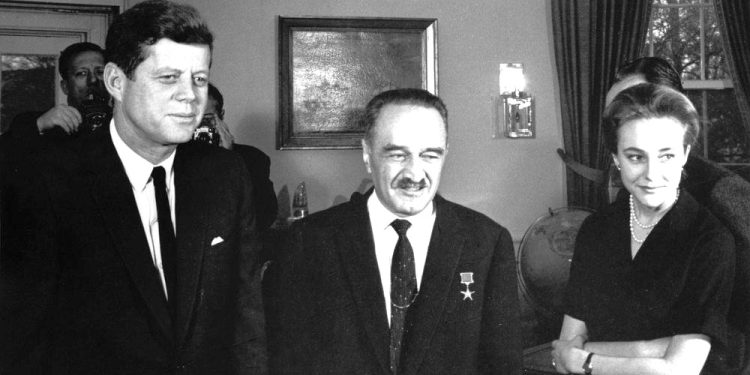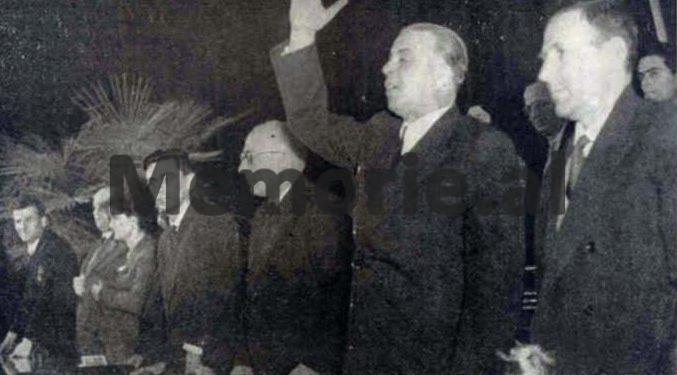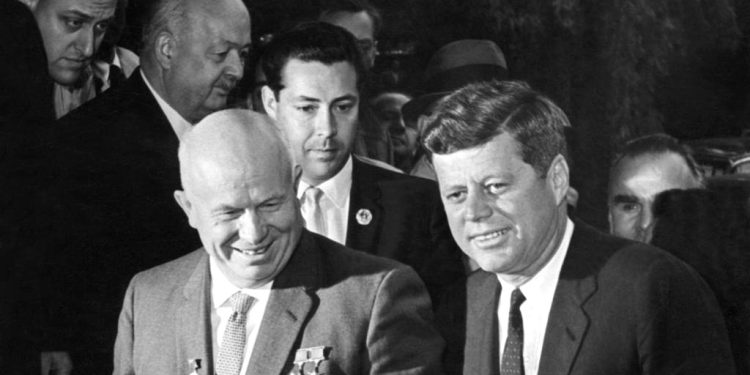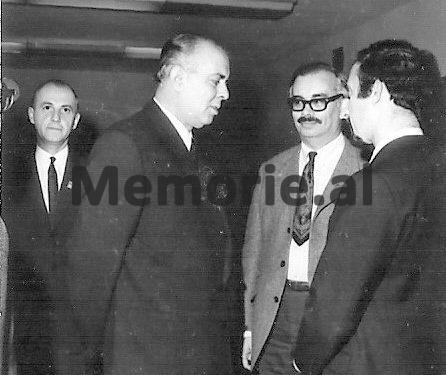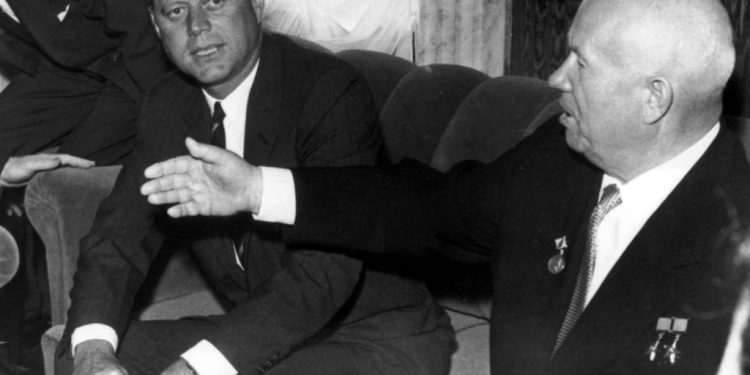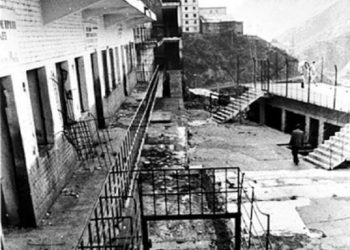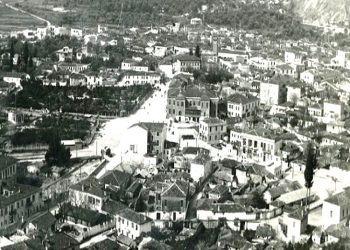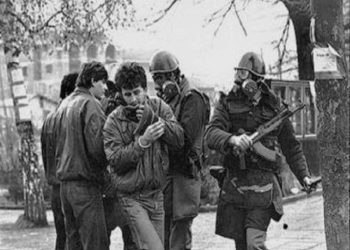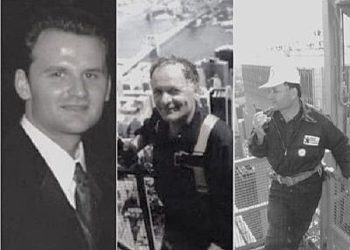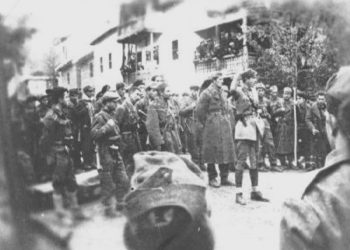By Prof. Dr. Ana LALAJ
Memorie.al / On October 16, 1962, at 11:30 AM, an emergency meeting was called at the White House. President John F. Kennedy had selected high-ranking officials for this secret meeting, including ministers, ambassadors, military personnel, and personal advisors. A total of 15 people. The Secretary of Defense placed on the table several photos of Soviet nuclear missiles installed in San Cristobal, Cuba, 90 miles off the coast of Florida. The President, as happens in these cases, sought advice before making decisions, laying out all action variants, from air, ground, and naval attack to a quarantine of Cuba. Only a passive stance on the new situation was ruled out. Finally, it was decided to implement a naval quarantine against foreign ships sailing toward Cuba. John Kennedy ordered that everything said in that meeting be kept “top secret.” This was for several reasons: the American people might panic, the Cubans might mask and hide the missile bases, the Soviets might attack if they had completed the missile installation, and finally, to allow time for diplomacy to act. It was decided that the group would meet daily, and each, in their field, would offer opinions on anticipated actions. Later, this working group, led by the President himself, was called the Temporary Executive Committee of the National Security Council (EXCOMM). The first meeting of the Executive Committee on October 16 marks the first day of the crisis. These 13 days (October 16–28, 1962) are considered among the most culminating points of the Cold War, the most confrontational moment between the two superpowers, and the most critical, where humanity found itself very close to a nuclear war. In political terminology, this moment is known by Americans as the “Cuban Missile Crisis,” by Soviet sources as the “Caribbean Crisis,” while the Cubans themselves call it the “October Crisis.”
A Chronicle of the Crisis
On October 22, 1962, the silence was broken. John Kennedy, on one of the radio and television networks, informed the American and international public that: “A series of offensive missile launching pads, directed against the Western Hemisphere,” meaning the American continent, “have been established in Cuba.” Even though American U-2 planes had gathered enough data on the bases, the Soviet Union denied having Soviet missiles in Cuba. Nevertheless, the American President publicly demanded that Soviet leader Nikita Khrushchev immediately stop the shipment of Soviet offensive weapons to Cuba and withdraw the existing ones from Cuba, and not undertake any counteraction, as any attack from Cuban territory against a state on the American continent would be considered an attack by the Soviet Union against the USA.
On October 23, Nikita Khrushchev responded to John Kennedy, saying he was interfering in Cuba’s internal affairs, that the weapons in Cuba were defensive in nature, that the Soviet Union would respond if Soviet ships were attacked by US ships, and that the US was threatening world peace. The next day, October 24, the American government established the naval quarantine against foreign ships sailing toward Cuba. The order was to sink any ship that did not comply with the inspection. That same day, Nikita Khrushchev, in another telegram addressed to John Kennedy, escalated the tone even more, writing with threatening notes that the Soviets would not stand as spectators to this “piratical act of American ships.”
Meanwhile, in Cuba, work continued non-stop on installing the Soviet missiles and making them operational. In the communist bloc, demonstrations, rallies, and government declarations were staged. John Kennedy’s accusations of Soviet nuclear missiles in Cuba were called “fabrications,” “blackmail,” or a “casus belli.” In Albania too, numerous meetings were organized among workers in factories, youth in schools and universities, and intellectuals in various institutions, in support of Cuba. The newspaper “Zëri i Popullit” (Voice of the People) was filled with articles: “Imperialism will fail,” “Cuba will win,” “Cuba yes, Yankee no,” as well as resolutions and protests sent to the UN Security Council and the Cuban government.
On October 25, the Albanian government issued a declaration calling John Kennedy’s accusation “an absurd pretext,” that “allegedly an offensive military force is being created in Cuba that is threatening the USA and the entire Western Hemisphere.” According to the Albanian government, “Cuba has the right to have all the weapons it deems necessary and does not have to account to anyone for this…! These unprecedented actions in peacetime are directed not only against Cuba but against all free and sovereign peoples, against peace and international security…” In his own notes, Enver Hoxha expressed satisfaction with the propaganda and support being given to Cuba.
But this entire propaganda storm was quickly seen to have been raised on slippery ground. Nikita Khrushchev himself, the crisis’s initiator, understood this faster and better than anyone else. The slogan of “defending the Cuban revolution from a possible American attack” was merely a cover for the true motives of competition between the two superpowers in the Cold War. Megalomaniacal as he was, Khrushchev was mistaken when he thought that the US would accept the deployment of Soviet missiles in Cuba as calmly as the Soviet Union had accepted the deployment of American missiles in Turkey. He had not heeded the advice of his Foreign Minister, Andrei Gromyko, who had warned that this action “would cause an explosion in the US.” And that is exactly what happened. For Khrushchev, it was now clear that the American government would not stop short of a military attack on Cuba to remove the missiles.
The Game of Two Telegrams: October 26 or 27?!
On October 26, 1962, in language entirely different from previous communications, Nikita Khrushchev wrote a long confidential telegram to John Kennedy, which arrived at the American embassy in Moscow at 4:43 PM. Khrushchev appealed to John Kennedy’s humane feelings and reason. Khrushchev admitted that “there are Soviet nuclear missiles in Cuba.” But according to him: “You and we should not exacerbate things,… because in war, other laws apply.” You understand very well what a terrible force our countries possess…! We are ready to enter into negotiations…! I propose that we declare that our ships will not carry weapons to Cuba. While you will declare that the US will not invade Cuba or will not support any other force aiming to carry out the invasion of Cuba. Then the presence of our military specialists in Cuba will no longer be necessary. If you agree, let’s end this situation that has troubled so many people…”
Nikita Khrushchev’s telegram of October 26, 1962, was well-received at the White House as a responsible approach by a statesman to normalize Soviet-American relations, de-escalate the situation in the Caribbean, and, above all, preserve world peace. But the unexpected happened. The next day, October 27, Nikita Khrushchev, on behalf of the Soviet government, broadcast a Declaration by radio, which arrived as a telegram several hours later at the White House and which brought back anxiety, uncertainty, and anger. The October 27 telegram, unlike the one a day earlier, was challenging and put the American government in a difficult position.
In it, Nikita Khrushchev accused the American government of “having surrounded the Soviet Union with nuclear weapons bases, in England, Italy, and Turkey…”; that “The Soviet Union would remove the missiles from Cuba, provided that the US also withdraws their analogous weapons (‘Jupiter’ missiles) from Turkey…”. The telegram stated that the Soviet Union would promise at the UN Security Council that it would respect Turkey’s integrity and would not intervene in its internal affairs, but the US should also promise the same for Cuba. For this, an agreement needed to be made on the time required to carry out the withdrawal of missiles from Cuba.
What is the reason for this sudden change? In the declassified documents of the Russian archives, this moment of duality is not found to be explained. While American documents state that; in the Executive Committee next to President John Kennedy, urgently convened, the opinion emerged that Nikita Khrushchev must have been under the pressure of Soviet generals or extremist policymakers who imposed radical policies. The American President was suggested to consider only the telegram of October 26, 1962, and to reply only to it. That is what was done. The American President’s first request was that, under UN observation, Soviet offensive weapons be removed from Cuba and no more such weapons be sent. Just as he agreed to quickly cancel the quarantine measures and ensure that he renounced an attack against Cuba. “I hope,” he concluded, “that we will quickly reach an agreement based on the proposals expressed in this message of mine and your message of October 26.” The withdrawal of American missiles from Turkey was not mentioned in the telegram. Members of the Executive Committee did not accept that the removal of Soviet missiles from Cuba should be conditional and part of a “bargain” with the Jupiter missiles in Turkey. According to them, this would be interpreted by the Soviets as a sign of US weakness, while by NATO as an act of infidelity toward an allied country like Turkey.
The Public Message and an Unwritten Security Message
Nevertheless, in a narrow meeting of only 6 of the 15 members of the Executive Committee, it was assessed that ignoring the second telegram (of October 27) would put Khrushchev in a terrible position. He was asked to change the course of Soviet policy within a few hours. A way out had to be left open for the opponent. Therefore, it was decided that, along with the President’s telegram, an oral message should also be conveyed to the Soviet Ambassador in Washington D.C. In the confidential message to the Soviet government, security had to be given that the “Jupiter” missiles would be removed from Turkey within a short period, but this should not be made public, as it would cause great difficulties in the US’s relations with its Western allies, as well as for the US’s leadership role in NATO.
The telegram was handed over to Soviet Ambassador A. Dobrynin, in the US Department of Justice, by the Attorney General, Robert Kennedy, and was also given to the media so as not to “be delayed.” Robert Kennedy, the closest collaborator and brother of President John Kennedy, was also a friend of the Soviet Ambassador, with whom he maintained special private contacts. While handing over the President’s message, he reiterated to the Soviet Ambassador the American government’s determination to remove the missiles from Cuba at any cost and at the same time gave him the assurance for the relocation of the “Jupiter” missiles from Turkey. Thus, the secret assurance given by the Americans for the removal of the “Jupiter” missiles from Turkey became part of the public agreement for the removal of Soviet missiles from Cuba and the non-aggression against Cuba.
For a long time, this assurance slept in the American and Soviet archives. Even in the memoirs of Robert Kennedy and Nikita Khrushchev, it does not appear very clearly. The truth came to light only after the declassification and publication of Soviet Ambassador A. Dobrynin’s telegram to the Soviet Foreign Minister, Andrei Gromyko, immediately after the meeting with Robert Kennedy, and the affirmations of the American President’s special correspondent, Theodore Sorensen, in the early 1990s. October 27, the day the telegram was discussed, drafted, and sent, is considered the peak of the crisis. On that day, an American “U-2” plane flying for observation over Cuban territory was hit by anti-aircraft forces, and the American pilot was killed.
The CIA, in a special report, informed that work on the installation of missiles in Cuba was continuing with intensity. In this atmosphere, American generals were anxiously awaiting the launch of the attack against Cuba. “I would never want to experience another Saturday night like this in my life,” wrote Defense Secretary Robert McNamara, a supporter of the blockade but not of armed action against Cuba, in his book “The Fog of War”. Everyone was anxiously and impatiently awaiting Nikita Khrushchev’s reaction.
The long-awaited answer arrived on the morning of October 28, initially through radio waves. “I received your message of October 27, 1962,” Nikita Khrushchev noted, “…and I express my satisfaction and gratitude for the understanding and responsibility you are manifesting at the present moment, to preserve peace in the world…! The Soviet government, along with instructions to stop the construction of the missile bases, has issued a new order for the dismantling of the weapons which you have described as; ‘offensive’…”! When the Soviet Ambassador handed the telegram to Robert Kennedy, the latter, after a quick glance, said: “This is a great relief”!
He returned once again to his concern regarding the promise of the “Jupiter” missiles and instructed the Soviet Ambassador that “correspondents should not reveal anything.” Ambassador A. Dobrynin replied: “In the embassy, besides me, no one knows about yesterday’s conversation with you.” Robert Kennedy asked the Ambassador that in the future for important diplomatic issues, he should contact him directly, without intermediaries, and gave him a secret phone number. Khrushchev’s message of October 28, in fact, ended the crisis. The American President immediately expressed his satisfaction through a speech on VOA (“Voice of America”).
Reasoning About the Crisis: Sources, Consequences…
Sixty-odd years have passed since the world found itself in the sharpest political and diplomatic confrontation of the half-century of the Cold War. Humanity narrowly avoided being engulfed in a devastating nuclear catastrophe. Chroniclers, scholars, and politicians of all kinds have dealt with the event. Today, with the declassification of information, the possibilities for increasingly accurate assessments have expanded. One can judge better the tendencies of the time, the parallel developments and clashes between the great powers, and why not the stubbornness of leaders and staffs, which not infrequently have put and continue to put the world in difficulty and dilemmas. This is what happened with the Caribbean Crisis. It has its responsible authors, without a doubt, the main one being Khrushchev himself. But it also bears the stamp of the political and military developments of that time, which remains a subject for study and interpretation.
In terms of temporal contexts, even in the case of the Caribbean crisis, the competition between the US and the Soviet Union remains decisive. Nikita Khrushchev affirmed in the process of de-Stalinization of his country’s life and the communist bloc, which he initiated and led, came to foreign policy with appeasing ideas, such as the slogans of “peaceful coexistence between the two systems” and “complete and general disarmament,” etc. This was the façade. Beyond it, the world was moving in another direction. On the morning of August 13, 1961, West Berliners found themselves surrounded by a barbed wire fence, which later turned into a wall. This was done with Khrushchev’s approval, something Stalin had been asked to do in his time but had refused.
Thus, the Berlin Crisis was followed by the Caribbean Crisis, which different scholars view as inseparable from each other. Khrushchev had created the impression that he had achieved a victory with Berlin, closing the last loophole in the “Iron Curtain” in Europe. This was an indirect blow to America. But he overestimated his own forces when he decided to cross the Atlantic and confront America at its very gates. The medium-range missiles installed in Cuba would also help Khrushchev establish a balance of missiles and powers with the US, which possessed far more intercontinental (long-range) nuclear missiles.
Another reason why Khrushchev decided to install medium-range nuclear missiles at an optimal point of action against America is related to what years later Valentin V. Larinov, a Soviet general, called “nuclear romanticism.” Until then, it was thought that the nuclear race served to increase the offensive and defensive capabilities only of the side that possessed them. High-ranking military personnel in both blocs were caught up in the euphoria of the possibility of eliminating the opponent to the point of extermination and nourished the certainty that for themselves, the damages would be tolerable.
But what was Cuba’s role in these events? Cuba was interested in increasing its military capability and accepted Khrushchev’s request to deploy the missiles there. But the Cuban authorities had no right over these weapons; they were entirely under Soviet administration. It seems strange, but during the crisis days, Fidel Castro and the other Cuban leaders had no information at all about what was happening with the bases on their soil. Moreover, Fidel Castro only learned about Khrushchev’s response to withdraw the missiles on October 28 from the radio. This greatly angered Castro. To ease the situation there, Mikoyan himself, one of the main figures of the Soviet leadership and respected by the Cubans – who even said that “there is a Cuban in the Central Committee of the Soviet Union”- was “installed.”
But this time it was different. Fidel Castro was not convinced and did not accept international control for the removal of the missiles. The interest shown by the Albanian leadership, especially by Enver Hoxha, who daily gave instructions for manifestations in “support of the Cuban people,” is notable regarding the Caribbean crisis. Even though humanity breathed freely after the Khrushchev–Kennedy agreement, Enver Hoxha called Khrushchev’s stance a “capitulation” and an “act of cowardice.” In his political diary, he wrote:
“Khrushchev capitulated; he abandoned Cuba in the mud…! This is the new, greatest betrayal of the Soviet Union, of Marxism-Leninism, of the socialist camp, of peace.”
Then a question can be raised: Is this a stance in aid of peace or war? In our opinion, the similarity of Albania’s fate with Cuba’s, in terms of territorial size, sensitive geo-strategic position, limited economic and military capabilities, and unequal defensive alliances, had created a psychology of insecurity in Enver Hoxha, which prompted him to judge Nikita Khrushchev’s turning point negatively. It was even a fiercer judgment than that of Fidel Castro himself, who, even in those difficult moments, did not forget to express gratitude to Khrushchev in his correspondence.
On November 20, the Soviet missiles were dismantled and returned to the Soviet Union. On November 21, President John Kennedy formally ended the quarantine. The Soviets withdrew about 40 missiles and 5,000 military troops. Many years after the crisis, declassified documents revealed that the Soviets had about 60 medium-range missiles, 43,000 Soviet soldiers ready for war, and 270,000 armed Cubans in Cuba. The path of dialogue and formal and confidential messages used to resolve the Cuban missile crisis created further alternative opportunities for the removal of American missiles in Turkey and Italy, which was realized six months later. / Memorie.al




